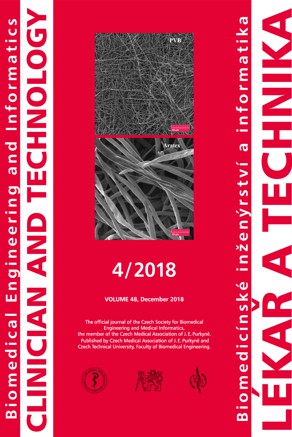Immediate Effect of Physical Exercise on Blood Flow Velocity in Radial Artery in Young Adults
Keywords:
blood flow velocity, radial artery, doppler ultrasound, local physical exerciseAbstract
Purpose: Quantify changes in blood flow velocity in radial artery after local dynamic exercise and compare these results between a group of women and men. Acquire data of normal resting blood flow in radial artery.
Methods: We examined 42 healthy young volunteers (21 men and 21 women) of the age about 20. A pocket Doppler ultrasound device was used for measurements. Physical exercise was defined as one-minute-long, one-handed weightlifting. Hemodynamic parameters were registered during resting before exercise and immediately after exercise.
Results: Resting baseline values: overall maximum blood flow velocity 26.49 cm/s (SD: 9.99 cm/s), mean blood flow velocity 8.46 cm/s (SD: 6.17 cm/s), and pulsatility index (PI) 5.46 (SD: 5.7) for the whole group. Mean percentage increase of maximum blood flow velocity is 36.5 %, mean blood flow velocity 243 %. PI was reduced by 52.8 %. There was a presumed significant difference in the percentage change of PI between the group of women and men (p<0.05). . There is also a typical change in velocity waveform after exercise. Conclusion: The most altered parameter is mean blood flow velocity, which corresponds to observed change of velocity waveform probably caused by local vasodilatation lasting only for several seconds.
Downloads
Published
Issue
Section
License
Copyright (c) 2019 Tomáš Jůza, Daniel Vlk

This work is licensed under a Creative Commons Attribution 4.0 International License.
Authors who publish with this journal agree to the following terms:
- Authors retain copyright and grant the journal right of the first publication with the work simultaneously licensed under a Creative Commons Attribution License (https://creativecommons.org/licenses/by/4.0/) that allows others to share the work with an acknowledgment of the work's authorship and initial publication in CTJ.
- Authors are able to enter into separate, additional contractual arrangements for the non-exclusive distribution of the journal’s published version of the work (e.g., post it to an institutional repository or publish it in a book), with an acknowledgment of its initial publication in this journal.
- Authors are permitted and encouraged to post their work online (e.g., in institutional repositories or on their website or ResearchGate) prior to and during the submission process, as it can lead to productive exchanges.
CTJ requires that all of the content of the manuscript has been created by its respective authors or that permission to use a copyrighted material has been obtained by the authors before submitting the manuscript to CTJ. CTJ requires that authors have not used any copyrighted material illegally, as for example a picture from another journal or book, a photo, etc. It is the author’s responsibility to use only materials not violating the copyright law. When in doubt, CTJ may ask the authors to supply the pertinent permission or agreement about the use of a copyrighted material.
The opinions expressed in CTJ articles are those of authors and do not necessarily reflect the views of the publishers or the Czech Society for Biomedical Engineering and Medical Informatics.


